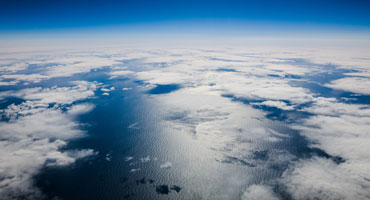Spectroscopy and atmospheric chemistry
Atmospheric chemistry

The Earth’s atmosphere is a complex and ever-changing mixture of gases and aerosol particles. Some changes occur slowly over the course of several years, such as the upward tends in background levels of tropospheric ozone. Other changes happen rapidly, such as the build-up of air pollutants over a single day. All these processes affect the air we breathe.
Gases are emitted into the atmosphere by natural and anthropogenic (manmade) processes. In terms of natural processes, our group studies the emission of iodine into the marine boundary layer from ozone reacting with iodide ions at the seawater’s surface. For anthropogenic processes, for example, we have quantified the primary and secondary sources of ultrafine aerosol particles, the sources of larger PM10 particles, and the emission of nitrous acid (HONO) from road vehicle exhausts.
Atmospheric composition also depends on the rates of chemical reactions taking place inside the atmosphere itself. We have previously studied the effects of NO3 radicals on the chemistry of the atmosphere at night. Using observations and chemical modelling, we also investigate ClNO2 as a source of Cl atoms that initiate the oxidation of volatile organic compounds during the first few hours of sunlight each day.
Selected publications
- “Nitrous Acid (HONO) Emissions Under Real-World Driving Conditions from Vehicles in a UK Road Tunnel”, L. J. Kramer, L. R. Crilley, T. J. Adams, S. M. Ball, F. D. Pope, W. J. Bloss, Atmos. Chem. Phys. 20, 5231–5248 (2020).
- “Seasonal and Geographical Variability of Nitryl Chloride and its Precursors in Northern Europe”, R. Sommariva, L. D. J. Hollis, T. Sherwen, A. R. Baker, S. M. Ball, B. J. Bandy, T. G. Bell, M. N. Chowdhury, R. L. Cordell, M. J. Evans, J. D. Lee, C. Reed, C. E. Reeves, J. M. Roberts, M. Yang, P. S. Monks, Atmos. Sci. Lett. 19, e844 (2018).
- “Tropospheric Ozone and its Precursors from the Urban to the Global Scale from Air Quality to Short-Lived Climate Forcer”, P.S. Monks et al., Atmos. Chem. Phys. 15, 8889-8973 (2015).